Big Data Analysis and Its Impact on the Financial Industry Report
VerifiedAdded on 2020/04/15
|9
|1809
|108
Report
AI Summary
This report delves into the significant applications of Big Data within the financial sector, emphasizing its role in data analysis, storage, and management. It begins by outlining Big Data technologies and tools, including infrastructure, data analytics, and storage platforms, supported by statistical data illustrating its growing importance. The report then explores Big Data adoption across various industries, highlighting its impact on retail, transportation, and government sectors. A major focus is placed on the financial industry, detailing how Big Data enhances risk management, customer data analysis, and operational efficiency. A case study of Deutsche Bank showcases the practical implementation of Big Data for risk mitigation and data analysis. The report concludes by summarizing the benefits of Big Data in the financial sector, emphasizing its potential to transform operations and improve decision-making. The report is available on Desklib, a platform providing AI-based study tools.

Running head: MANAGEMENT INFORMATION SYSTEMS
Management Information Systems
Name of the Student
Name of the University
Author Note
Management Information Systems
Name of the Student
Name of the University
Author Note
Paraphrase This Document
Need a fresh take? Get an instant paraphrase of this document with our AI Paraphraser
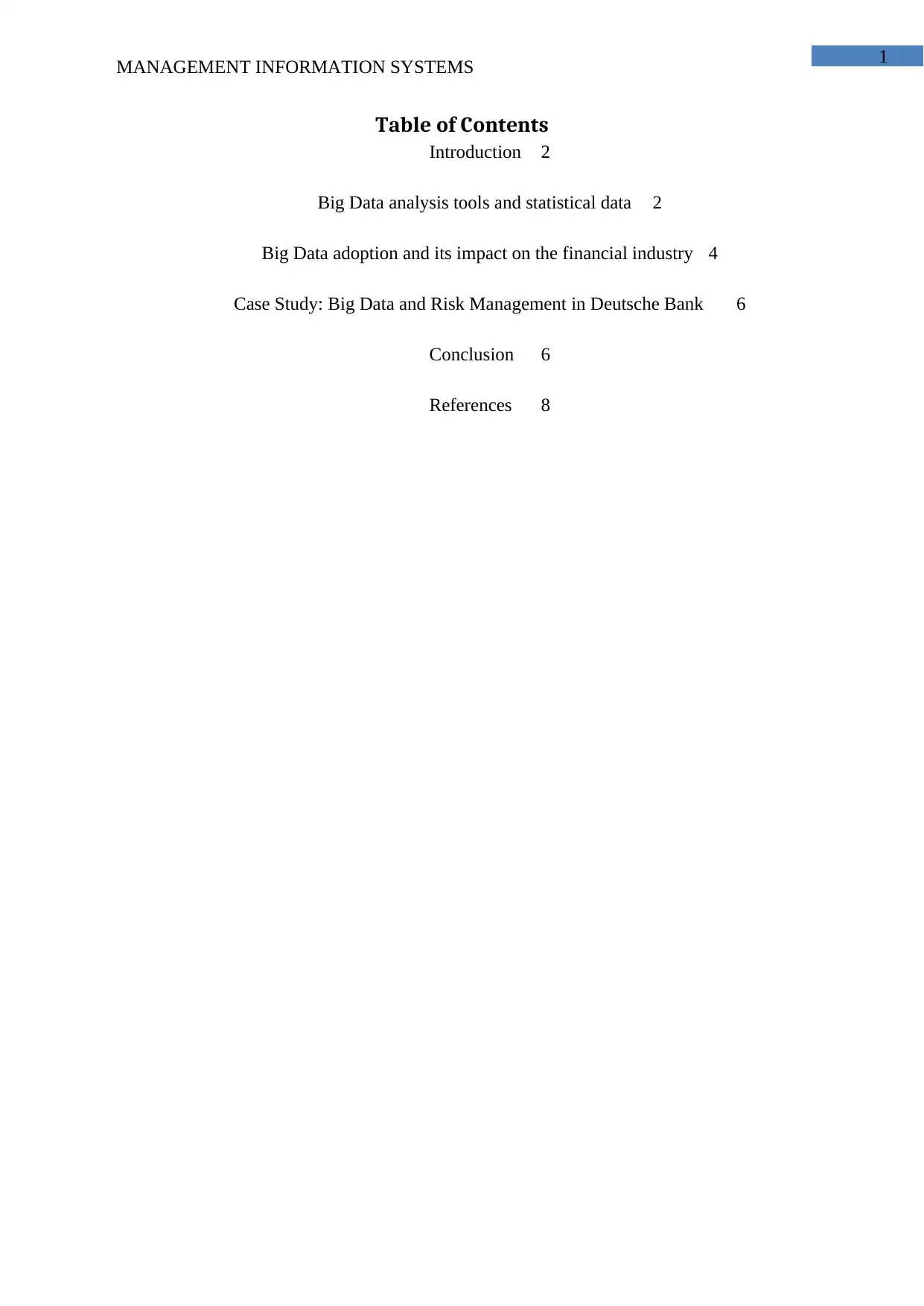
1
MANAGEMENT INFORMATION SYSTEMS
Table of Contents
Introduction 2
Big Data analysis tools and statistical data 2
Big Data adoption and its impact on the financial industry 4
Case Study: Big Data and Risk Management in Deutsche Bank 6
Conclusion 6
References 8
MANAGEMENT INFORMATION SYSTEMS
Table of Contents
Introduction 2
Big Data analysis tools and statistical data 2
Big Data adoption and its impact on the financial industry 4
Case Study: Big Data and Risk Management in Deutsche Bank 6
Conclusion 6
References 8
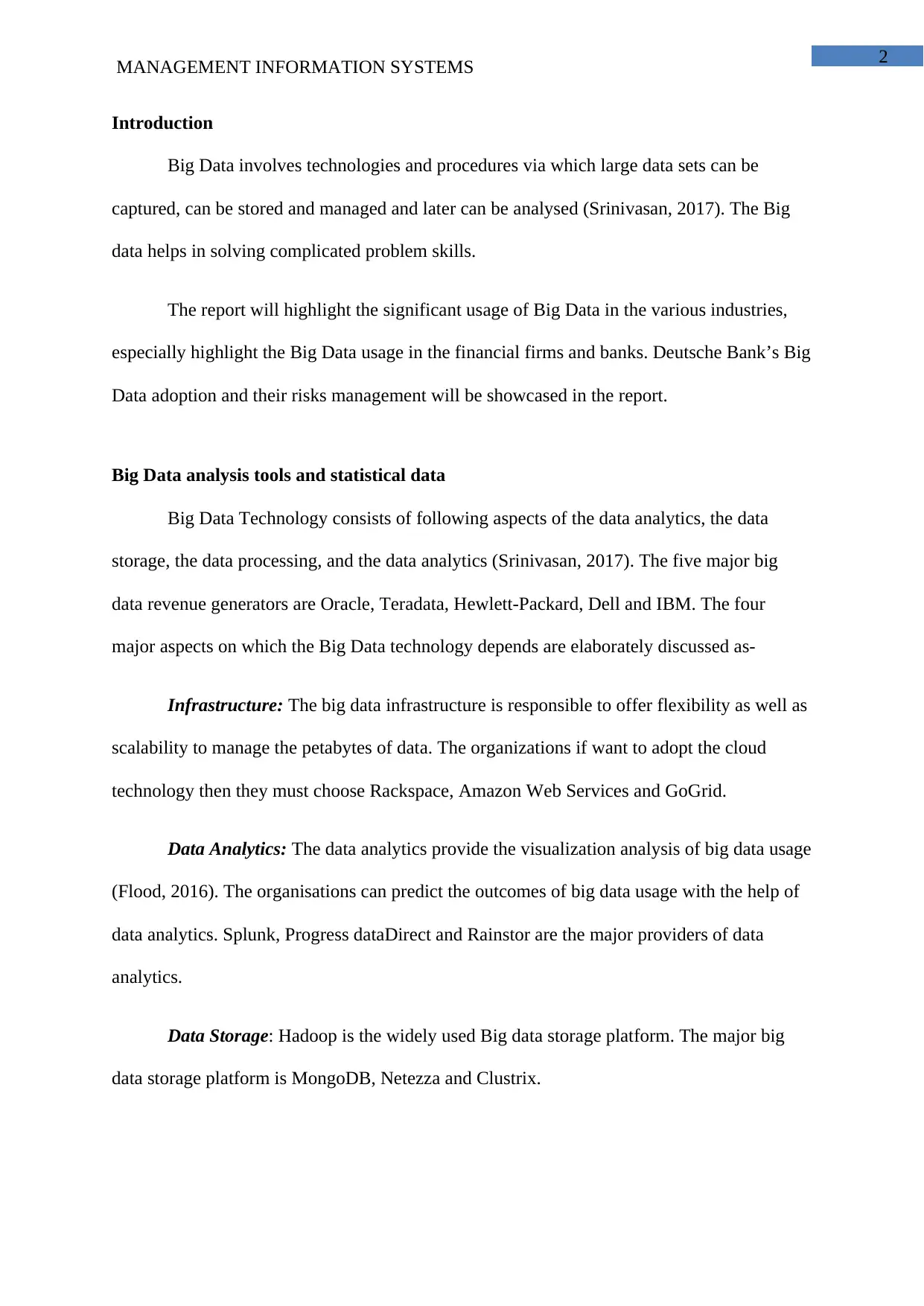
2
MANAGEMENT INFORMATION SYSTEMS
Introduction
Big Data involves technologies and procedures via which large data sets can be
captured, can be stored and managed and later can be analysed (Srinivasan, 2017). The Big
data helps in solving complicated problem skills.
The report will highlight the significant usage of Big Data in the various industries,
especially highlight the Big Data usage in the financial firms and banks. Deutsche Bank’s Big
Data adoption and their risks management will be showcased in the report.
Big Data analysis tools and statistical data
Big Data Technology consists of following aspects of the data analytics, the data
storage, the data processing, and the data analytics (Srinivasan, 2017). The five major big
data revenue generators are Oracle, Teradata, Hewlett-Packard, Dell and IBM. The four
major aspects on which the Big Data technology depends are elaborately discussed as-
Infrastructure: The big data infrastructure is responsible to offer flexibility as well as
scalability to manage the petabytes of data. The organizations if want to adopt the cloud
technology then they must choose Rackspace, Amazon Web Services and GoGrid.
Data Analytics: The data analytics provide the visualization analysis of big data usage
(Flood, 2016). The organisations can predict the outcomes of big data usage with the help of
data analytics. Splunk, Progress dataDirect and Rainstor are the major providers of data
analytics.
Data Storage: Hadoop is the widely used Big data storage platform. The major big
data storage platform is MongoDB, Netezza and Clustrix.
MANAGEMENT INFORMATION SYSTEMS
Introduction
Big Data involves technologies and procedures via which large data sets can be
captured, can be stored and managed and later can be analysed (Srinivasan, 2017). The Big
data helps in solving complicated problem skills.
The report will highlight the significant usage of Big Data in the various industries,
especially highlight the Big Data usage in the financial firms and banks. Deutsche Bank’s Big
Data adoption and their risks management will be showcased in the report.
Big Data analysis tools and statistical data
Big Data Technology consists of following aspects of the data analytics, the data
storage, the data processing, and the data analytics (Srinivasan, 2017). The five major big
data revenue generators are Oracle, Teradata, Hewlett-Packard, Dell and IBM. The four
major aspects on which the Big Data technology depends are elaborately discussed as-
Infrastructure: The big data infrastructure is responsible to offer flexibility as well as
scalability to manage the petabytes of data. The organizations if want to adopt the cloud
technology then they must choose Rackspace, Amazon Web Services and GoGrid.
Data Analytics: The data analytics provide the visualization analysis of big data usage
(Flood, 2016). The organisations can predict the outcomes of big data usage with the help of
data analytics. Splunk, Progress dataDirect and Rainstor are the major providers of data
analytics.
Data Storage: Hadoop is the widely used Big data storage platform. The major big
data storage platform is MongoDB, Netezza and Clustrix.
⊘ This is a preview!⊘
Do you want full access?
Subscribe today to unlock all pages.

Trusted by 1+ million students worldwide
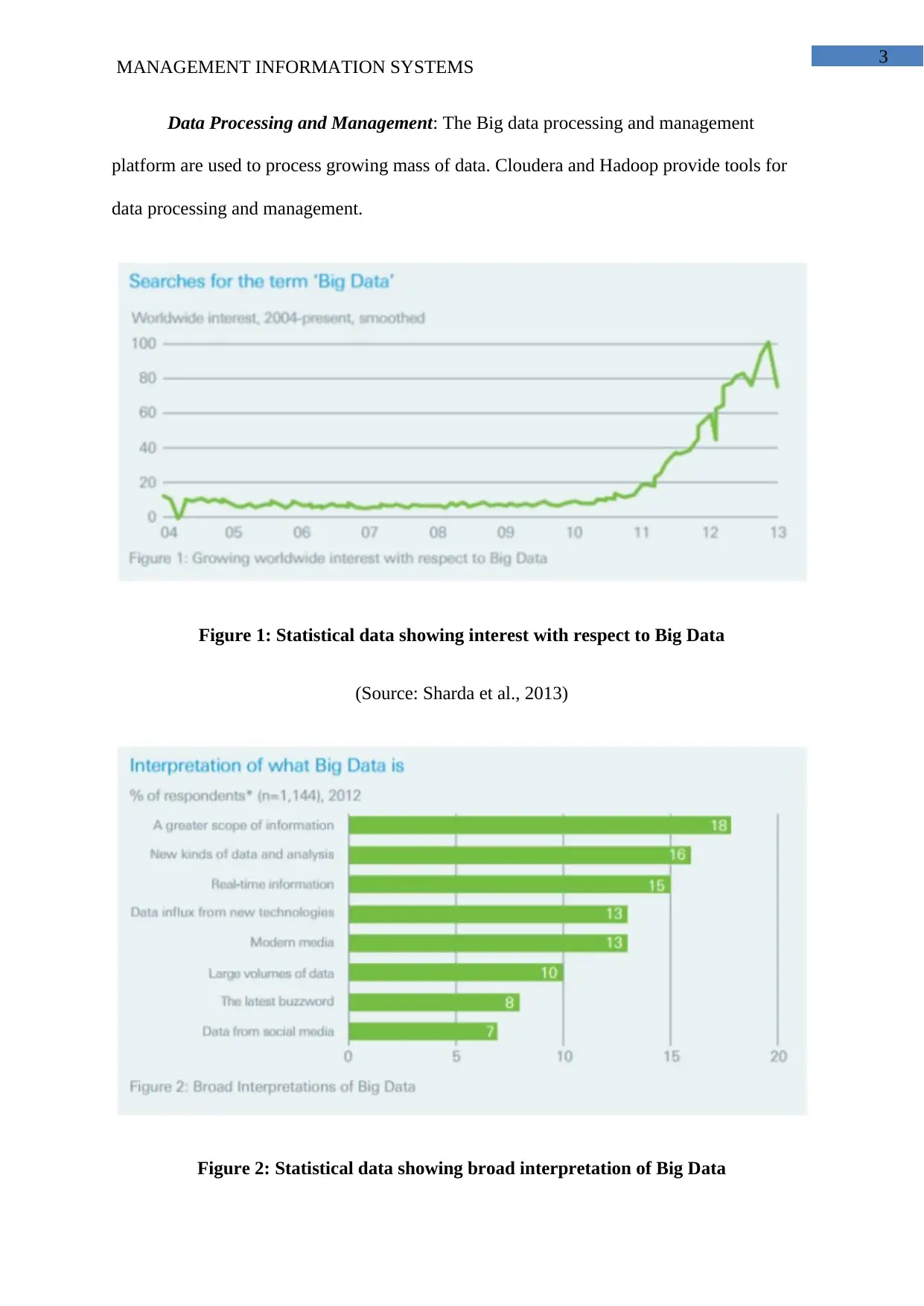
3
MANAGEMENT INFORMATION SYSTEMS
Data Processing and Management: The Big data processing and management
platform are used to process growing mass of data. Cloudera and Hadoop provide tools for
data processing and management.
Figure 1: Statistical data showing interest with respect to Big Data
(Source: Sharda et al., 2013)
Figure 2: Statistical data showing broad interpretation of Big Data
MANAGEMENT INFORMATION SYSTEMS
Data Processing and Management: The Big data processing and management
platform are used to process growing mass of data. Cloudera and Hadoop provide tools for
data processing and management.
Figure 1: Statistical data showing interest with respect to Big Data
(Source: Sharda et al., 2013)
Figure 2: Statistical data showing broad interpretation of Big Data
Paraphrase This Document
Need a fresh take? Get an instant paraphrase of this document with our AI Paraphraser
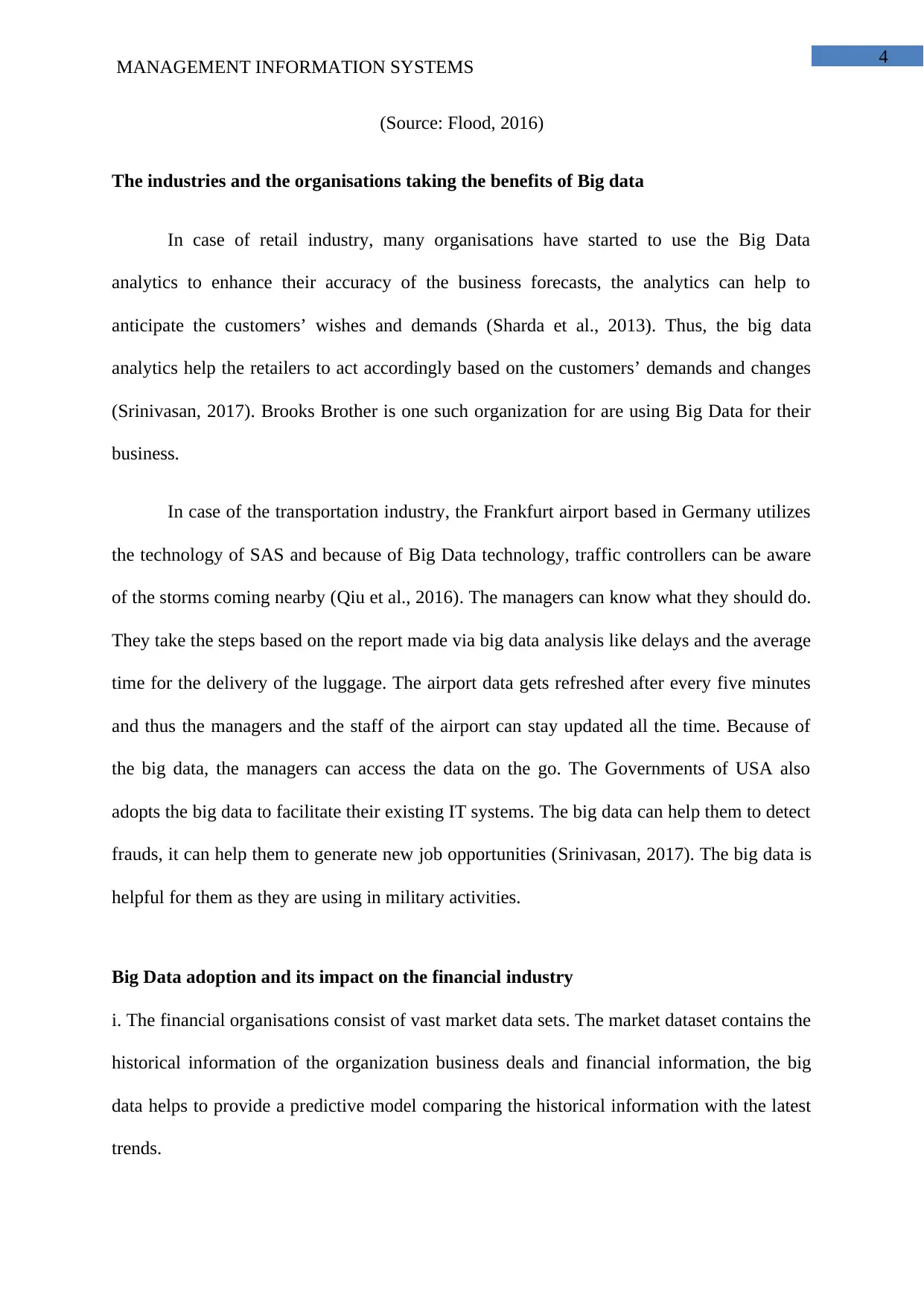
4
MANAGEMENT INFORMATION SYSTEMS
(Source: Flood, 2016)
The industries and the organisations taking the benefits of Big data
In case of retail industry, many organisations have started to use the Big Data
analytics to enhance their accuracy of the business forecasts, the analytics can help to
anticipate the customers’ wishes and demands (Sharda et al., 2013). Thus, the big data
analytics help the retailers to act accordingly based on the customers’ demands and changes
(Srinivasan, 2017). Brooks Brother is one such organization for are using Big Data for their
business.
In case of the transportation industry, the Frankfurt airport based in Germany utilizes
the technology of SAS and because of Big Data technology, traffic controllers can be aware
of the storms coming nearby (Qiu et al., 2016). The managers can know what they should do.
They take the steps based on the report made via big data analysis like delays and the average
time for the delivery of the luggage. The airport data gets refreshed after every five minutes
and thus the managers and the staff of the airport can stay updated all the time. Because of
the big data, the managers can access the data on the go. The Governments of USA also
adopts the big data to facilitate their existing IT systems. The big data can help them to detect
frauds, it can help them to generate new job opportunities (Srinivasan, 2017). The big data is
helpful for them as they are using in military activities.
Big Data adoption and its impact on the financial industry
i. The financial organisations consist of vast market data sets. The market dataset contains the
historical information of the organization business deals and financial information, the big
data helps to provide a predictive model comparing the historical information with the latest
trends.
MANAGEMENT INFORMATION SYSTEMS
(Source: Flood, 2016)
The industries and the organisations taking the benefits of Big data
In case of retail industry, many organisations have started to use the Big Data
analytics to enhance their accuracy of the business forecasts, the analytics can help to
anticipate the customers’ wishes and demands (Sharda et al., 2013). Thus, the big data
analytics help the retailers to act accordingly based on the customers’ demands and changes
(Srinivasan, 2017). Brooks Brother is one such organization for are using Big Data for their
business.
In case of the transportation industry, the Frankfurt airport based in Germany utilizes
the technology of SAS and because of Big Data technology, traffic controllers can be aware
of the storms coming nearby (Qiu et al., 2016). The managers can know what they should do.
They take the steps based on the report made via big data analysis like delays and the average
time for the delivery of the luggage. The airport data gets refreshed after every five minutes
and thus the managers and the staff of the airport can stay updated all the time. Because of
the big data, the managers can access the data on the go. The Governments of USA also
adopts the big data to facilitate their existing IT systems. The big data can help them to detect
frauds, it can help them to generate new job opportunities (Srinivasan, 2017). The big data is
helpful for them as they are using in military activities.
Big Data adoption and its impact on the financial industry
i. The financial organisations consist of vast market data sets. The market dataset contains the
historical information of the organization business deals and financial information, the big
data helps to provide a predictive model comparing the historical information with the latest
trends.
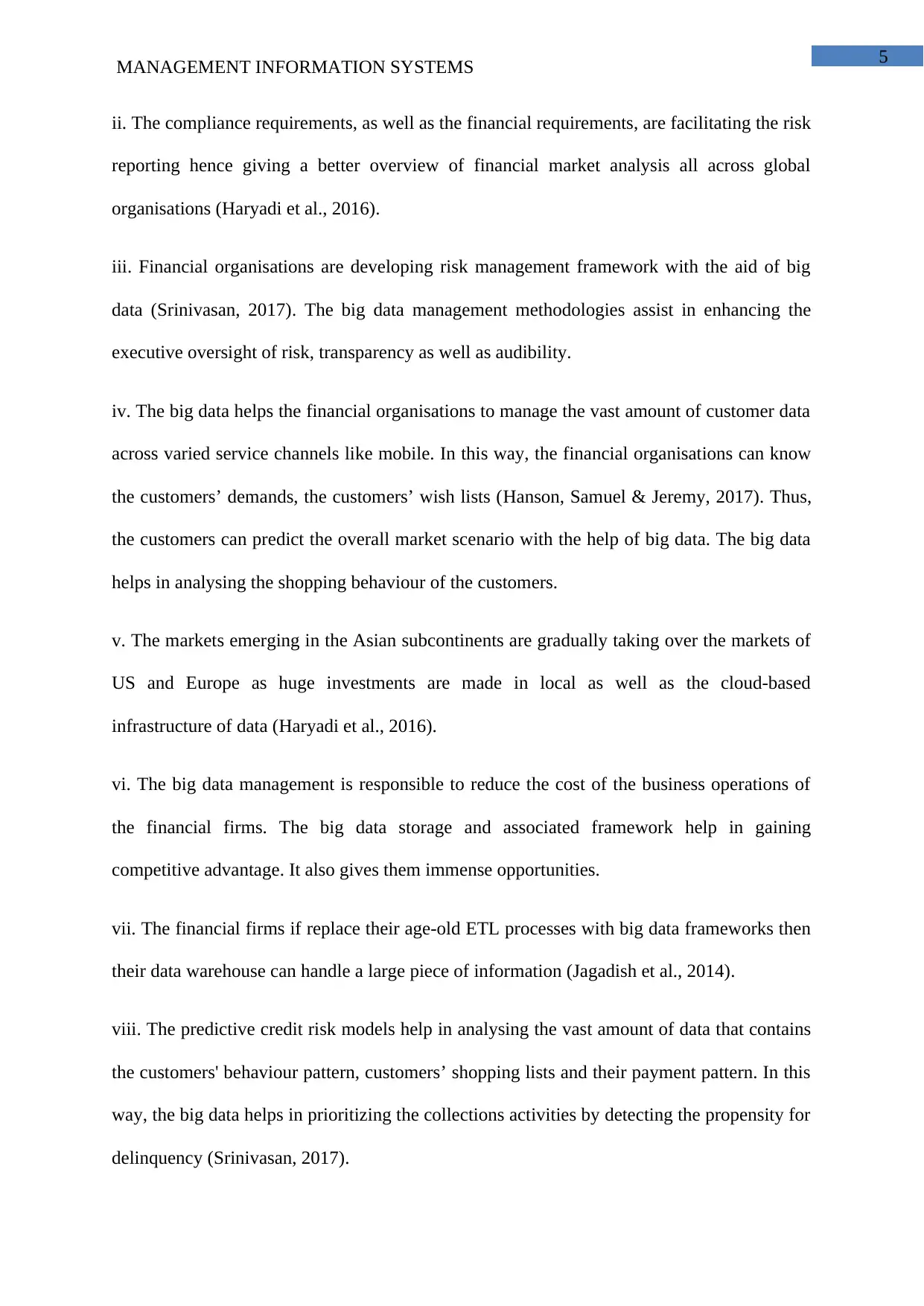
5
MANAGEMENT INFORMATION SYSTEMS
ii. The compliance requirements, as well as the financial requirements, are facilitating the risk
reporting hence giving a better overview of financial market analysis all across global
organisations (Haryadi et al., 2016).
iii. Financial organisations are developing risk management framework with the aid of big
data (Srinivasan, 2017). The big data management methodologies assist in enhancing the
executive oversight of risk, transparency as well as audibility.
iv. The big data helps the financial organisations to manage the vast amount of customer data
across varied service channels like mobile. In this way, the financial organisations can know
the customers’ demands, the customers’ wish lists (Hanson, Samuel & Jeremy, 2017). Thus,
the customers can predict the overall market scenario with the help of big data. The big data
helps in analysing the shopping behaviour of the customers.
v. The markets emerging in the Asian subcontinents are gradually taking over the markets of
US and Europe as huge investments are made in local as well as the cloud-based
infrastructure of data (Haryadi et al., 2016).
vi. The big data management is responsible to reduce the cost of the business operations of
the financial firms. The big data storage and associated framework help in gaining
competitive advantage. It also gives them immense opportunities.
vii. The financial firms if replace their age-old ETL processes with big data frameworks then
their data warehouse can handle a large piece of information (Jagadish et al., 2014).
viii. The predictive credit risk models help in analysing the vast amount of data that contains
the customers' behaviour pattern, customers’ shopping lists and their payment pattern. In this
way, the big data helps in prioritizing the collections activities by detecting the propensity for
delinquency (Srinivasan, 2017).
MANAGEMENT INFORMATION SYSTEMS
ii. The compliance requirements, as well as the financial requirements, are facilitating the risk
reporting hence giving a better overview of financial market analysis all across global
organisations (Haryadi et al., 2016).
iii. Financial organisations are developing risk management framework with the aid of big
data (Srinivasan, 2017). The big data management methodologies assist in enhancing the
executive oversight of risk, transparency as well as audibility.
iv. The big data helps the financial organisations to manage the vast amount of customer data
across varied service channels like mobile. In this way, the financial organisations can know
the customers’ demands, the customers’ wish lists (Hanson, Samuel & Jeremy, 2017). Thus,
the customers can predict the overall market scenario with the help of big data. The big data
helps in analysing the shopping behaviour of the customers.
v. The markets emerging in the Asian subcontinents are gradually taking over the markets of
US and Europe as huge investments are made in local as well as the cloud-based
infrastructure of data (Haryadi et al., 2016).
vi. The big data management is responsible to reduce the cost of the business operations of
the financial firms. The big data storage and associated framework help in gaining
competitive advantage. It also gives them immense opportunities.
vii. The financial firms if replace their age-old ETL processes with big data frameworks then
their data warehouse can handle a large piece of information (Jagadish et al., 2014).
viii. The predictive credit risk models help in analysing the vast amount of data that contains
the customers' behaviour pattern, customers’ shopping lists and their payment pattern. In this
way, the big data helps in prioritizing the collections activities by detecting the propensity for
delinquency (Srinivasan, 2017).
⊘ This is a preview!⊘
Do you want full access?
Subscribe today to unlock all pages.

Trusted by 1+ million students worldwide
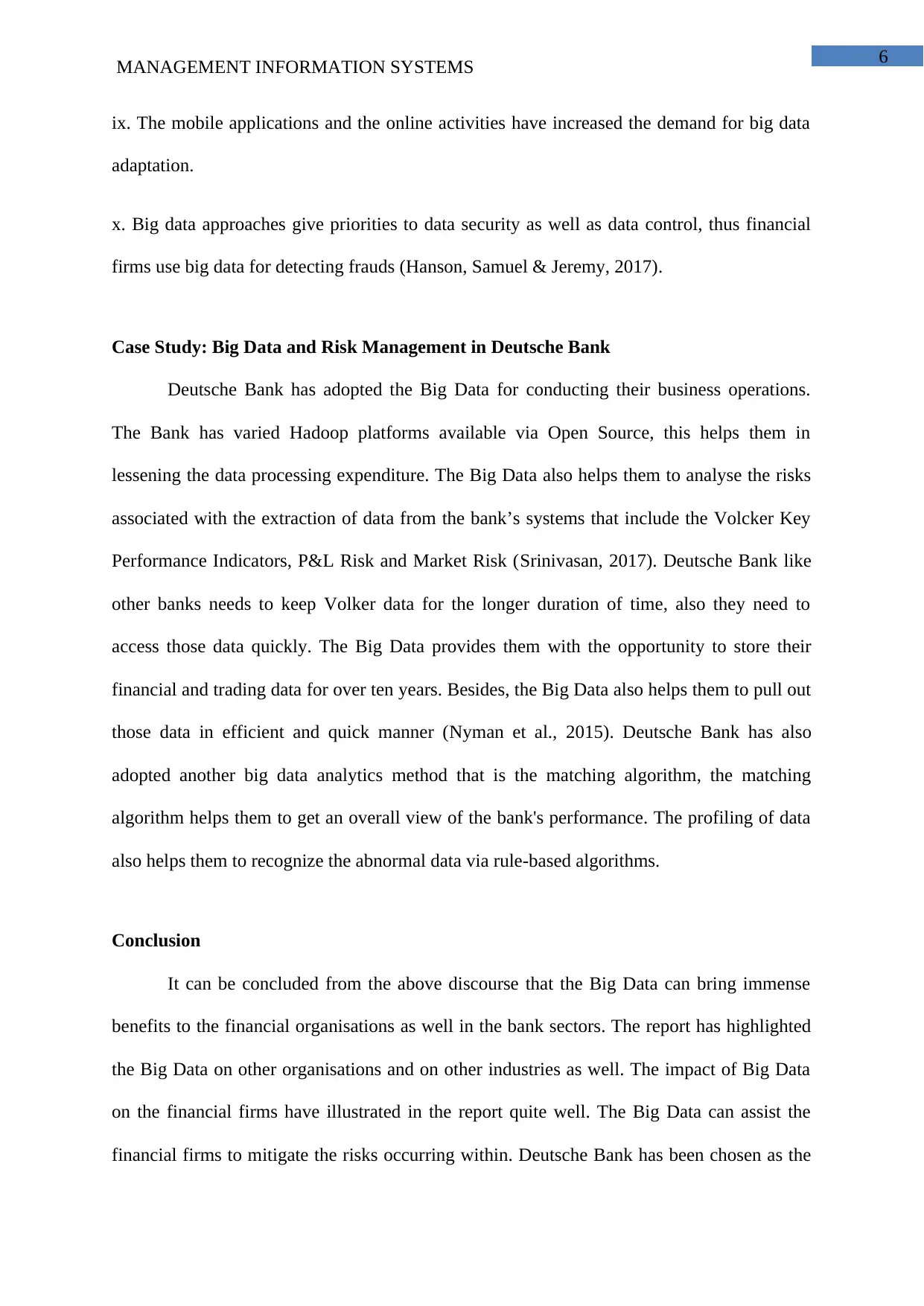
6
MANAGEMENT INFORMATION SYSTEMS
ix. The mobile applications and the online activities have increased the demand for big data
adaptation.
x. Big data approaches give priorities to data security as well as data control, thus financial
firms use big data for detecting frauds (Hanson, Samuel & Jeremy, 2017).
Case Study: Big Data and Risk Management in Deutsche Bank
Deutsche Bank has adopted the Big Data for conducting their business operations.
The Bank has varied Hadoop platforms available via Open Source, this helps them in
lessening the data processing expenditure. The Big Data also helps them to analyse the risks
associated with the extraction of data from the bank’s systems that include the Volcker Key
Performance Indicators, P&L Risk and Market Risk (Srinivasan, 2017). Deutsche Bank like
other banks needs to keep Volker data for the longer duration of time, also they need to
access those data quickly. The Big Data provides them with the opportunity to store their
financial and trading data for over ten years. Besides, the Big Data also helps them to pull out
those data in efficient and quick manner (Nyman et al., 2015). Deutsche Bank has also
adopted another big data analytics method that is the matching algorithm, the matching
algorithm helps them to get an overall view of the bank's performance. The profiling of data
also helps them to recognize the abnormal data via rule-based algorithms.
Conclusion
It can be concluded from the above discourse that the Big Data can bring immense
benefits to the financial organisations as well in the bank sectors. The report has highlighted
the Big Data on other organisations and on other industries as well. The impact of Big Data
on the financial firms have illustrated in the report quite well. The Big Data can assist the
financial firms to mitigate the risks occurring within. Deutsche Bank has been chosen as the
MANAGEMENT INFORMATION SYSTEMS
ix. The mobile applications and the online activities have increased the demand for big data
adaptation.
x. Big data approaches give priorities to data security as well as data control, thus financial
firms use big data for detecting frauds (Hanson, Samuel & Jeremy, 2017).
Case Study: Big Data and Risk Management in Deutsche Bank
Deutsche Bank has adopted the Big Data for conducting their business operations.
The Bank has varied Hadoop platforms available via Open Source, this helps them in
lessening the data processing expenditure. The Big Data also helps them to analyse the risks
associated with the extraction of data from the bank’s systems that include the Volcker Key
Performance Indicators, P&L Risk and Market Risk (Srinivasan, 2017). Deutsche Bank like
other banks needs to keep Volker data for the longer duration of time, also they need to
access those data quickly. The Big Data provides them with the opportunity to store their
financial and trading data for over ten years. Besides, the Big Data also helps them to pull out
those data in efficient and quick manner (Nyman et al., 2015). Deutsche Bank has also
adopted another big data analytics method that is the matching algorithm, the matching
algorithm helps them to get an overall view of the bank's performance. The profiling of data
also helps them to recognize the abnormal data via rule-based algorithms.
Conclusion
It can be concluded from the above discourse that the Big Data can bring immense
benefits to the financial organisations as well in the bank sectors. The report has highlighted
the Big Data on other organisations and on other industries as well. The impact of Big Data
on the financial firms have illustrated in the report quite well. The Big Data can assist the
financial firms to mitigate the risks occurring within. Deutsche Bank has been chosen as the
Paraphrase This Document
Need a fresh take? Get an instant paraphrase of this document with our AI Paraphraser

7
MANAGEMENT INFORMATION SYSTEMS
case study in this report. The Volcker Key Performance Indicators, P&L Risk and Market
Risk have been showcased that can be mitigated with the effective implementation of Big
Data.
MANAGEMENT INFORMATION SYSTEMS
case study in this report. The Volcker Key Performance Indicators, P&L Risk and Market
Risk have been showcased that can be mitigated with the effective implementation of Big
Data.
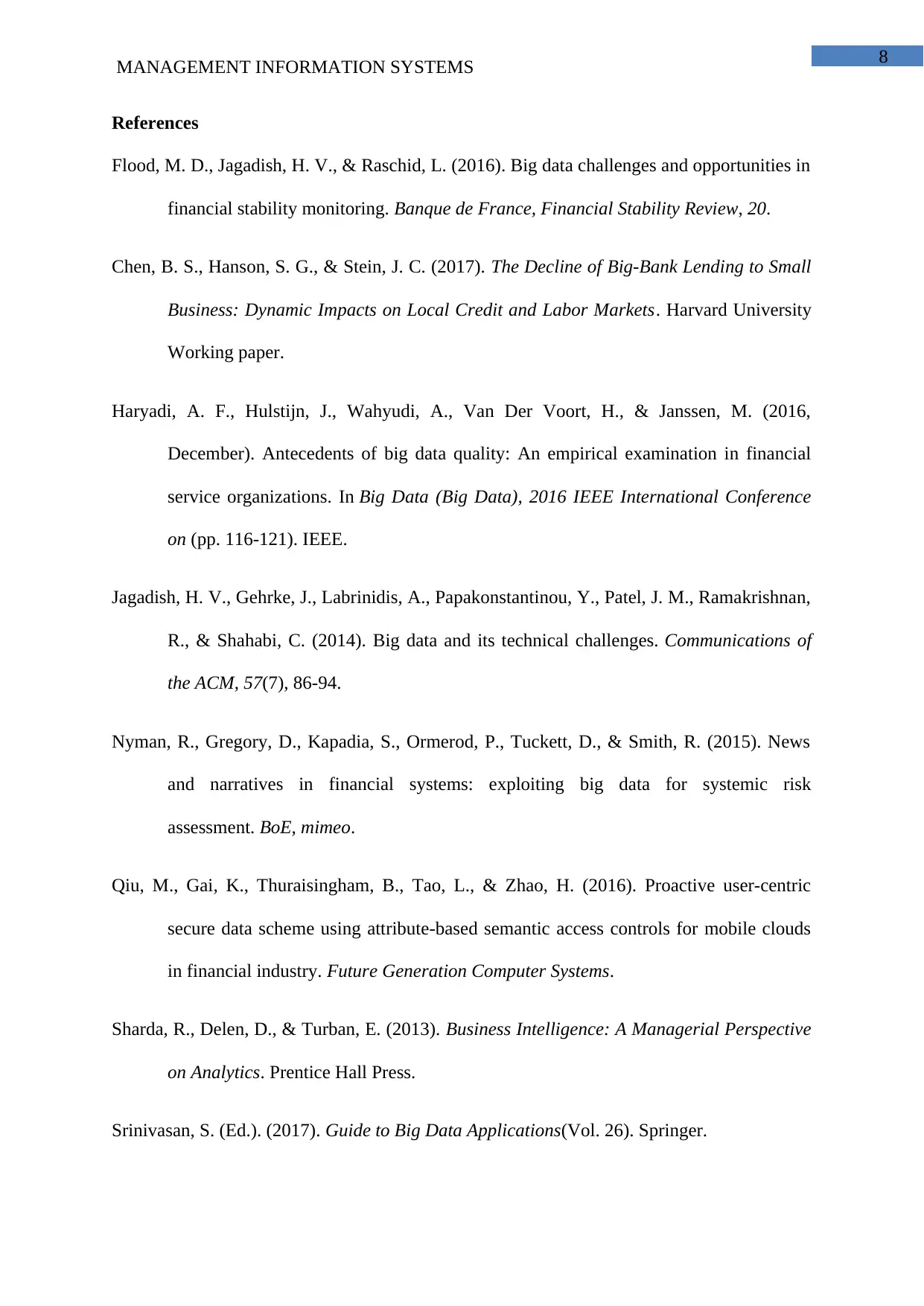
8
MANAGEMENT INFORMATION SYSTEMS
References
Flood, M. D., Jagadish, H. V., & Raschid, L. (2016). Big data challenges and opportunities in
financial stability monitoring. Banque de France, Financial Stability Review, 20.
Chen, B. S., Hanson, S. G., & Stein, J. C. (2017). The Decline of Big-Bank Lending to Small
Business: Dynamic Impacts on Local Credit and Labor Markets. Harvard University
Working paper.
Haryadi, A. F., Hulstijn, J., Wahyudi, A., Van Der Voort, H., & Janssen, M. (2016,
December). Antecedents of big data quality: An empirical examination in financial
service organizations. In Big Data (Big Data), 2016 IEEE International Conference
on (pp. 116-121). IEEE.
Jagadish, H. V., Gehrke, J., Labrinidis, A., Papakonstantinou, Y., Patel, J. M., Ramakrishnan,
R., & Shahabi, C. (2014). Big data and its technical challenges. Communications of
the ACM, 57(7), 86-94.
Nyman, R., Gregory, D., Kapadia, S., Ormerod, P., Tuckett, D., & Smith, R. (2015). News
and narratives in financial systems: exploiting big data for systemic risk
assessment. BoE, mimeo.
Qiu, M., Gai, K., Thuraisingham, B., Tao, L., & Zhao, H. (2016). Proactive user-centric
secure data scheme using attribute-based semantic access controls for mobile clouds
in financial industry. Future Generation Computer Systems.
Sharda, R., Delen, D., & Turban, E. (2013). Business Intelligence: A Managerial Perspective
on Analytics. Prentice Hall Press.
Srinivasan, S. (Ed.). (2017). Guide to Big Data Applications(Vol. 26). Springer.
MANAGEMENT INFORMATION SYSTEMS
References
Flood, M. D., Jagadish, H. V., & Raschid, L. (2016). Big data challenges and opportunities in
financial stability monitoring. Banque de France, Financial Stability Review, 20.
Chen, B. S., Hanson, S. G., & Stein, J. C. (2017). The Decline of Big-Bank Lending to Small
Business: Dynamic Impacts on Local Credit and Labor Markets. Harvard University
Working paper.
Haryadi, A. F., Hulstijn, J., Wahyudi, A., Van Der Voort, H., & Janssen, M. (2016,
December). Antecedents of big data quality: An empirical examination in financial
service organizations. In Big Data (Big Data), 2016 IEEE International Conference
on (pp. 116-121). IEEE.
Jagadish, H. V., Gehrke, J., Labrinidis, A., Papakonstantinou, Y., Patel, J. M., Ramakrishnan,
R., & Shahabi, C. (2014). Big data and its technical challenges. Communications of
the ACM, 57(7), 86-94.
Nyman, R., Gregory, D., Kapadia, S., Ormerod, P., Tuckett, D., & Smith, R. (2015). News
and narratives in financial systems: exploiting big data for systemic risk
assessment. BoE, mimeo.
Qiu, M., Gai, K., Thuraisingham, B., Tao, L., & Zhao, H. (2016). Proactive user-centric
secure data scheme using attribute-based semantic access controls for mobile clouds
in financial industry. Future Generation Computer Systems.
Sharda, R., Delen, D., & Turban, E. (2013). Business Intelligence: A Managerial Perspective
on Analytics. Prentice Hall Press.
Srinivasan, S. (Ed.). (2017). Guide to Big Data Applications(Vol. 26). Springer.
⊘ This is a preview!⊘
Do you want full access?
Subscribe today to unlock all pages.

Trusted by 1+ million students worldwide
1 out of 9
Related Documents
Your All-in-One AI-Powered Toolkit for Academic Success.
+13062052269
info@desklib.com
Available 24*7 on WhatsApp / Email
![[object Object]](/_next/static/media/star-bottom.7253800d.svg)
Unlock your academic potential
Copyright © 2020–2025 A2Z Services. All Rights Reserved. Developed and managed by ZUCOL.





